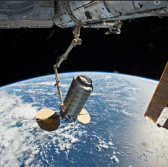 Northrop Grumman’s Cygnus spacecraft docked at the International Space Station tested on Tuesday its reboost capability through a 50-second engine firing activity, Spaceflight Now reported Wednesday.
Northrop Grumman’s Cygnus spacecraft docked at the International Space Station tested on Tuesday its reboost capability through a 50-second engine firing activity, Spaceflight Now reported Wednesday.
Ground controllers at Northrop’s Dulles, Va.-based mission operations facility transmitted commands to the spacecraft to fire its IHI Aerospace-supplied BT-4 main engine, which generated approximately 100 pounds of thrust that increased the space laboratory’s orbit by 295 feet.
“The spacecraft performed exactly as we expected. … We had an on-time ignition of the engine, and an on-time shutdown,†said Frank DeMauro, vice president and general manager of advanced programs division at Northrop’s innovation systems business.
Northrop Grumman Innovation Systems launched in June after its parent company completed its approximately $9.2 billion purchase of Orbital ATK.
The report said the test sought to demonstrate Cygnus’ capability to raise the space station’s orbit as Northrop and NASA plan to use the main engine to support future reboost maneuvers, which could help adjust the ISS’ orbit to avoid space debris.
The spacecraft that took off in May as part of the company’s ninth cargo resupply mission to the ISS is set to re-enter Earth on July 30 once it deploys six CubeSats on Sunday, July 15.




